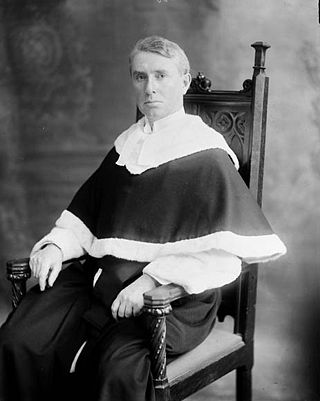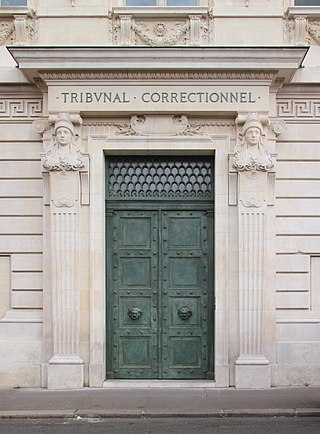Related Research Articles
In the United States, a state court has jurisdiction over disputes with some connection to a U.S. state. State courts handle the vast majority of civil and criminal cases in the United States; the United States federal courts are far smaller in terms of both personnel and caseload, and handle different types of cases. States often provide their trial courts with general jurisdiction and state trial courts regularly have concurrent jurisdiction with federal courts. Federal courts are courts of limited jurisdiction and their subject-matter jurisdiction arises only under federal law.
The courts of England and Wales, supported administratively by His Majesty's Courts and Tribunals Service, are the civil and criminal courts responsible for the administration of justice in England and Wales.

A justice of the peace (JP) is a judicial officer of a lower or puisne court, elected or appointed by means of a commission to keep the peace. In past centuries the term commissioner of the peace was often used with the same meaning. Depending on the jurisdiction, such justices dispense summary justice or merely deal with local administrative applications in common law jurisdictions. Justices of the peace are appointed or elected from the citizens of the jurisdiction in which they serve, and are usually not required to have any formal legal education in order to qualify for the office. Some jurisdictions have varying forms of training for JPs.

The term magistrate is used in a variety of systems of governments and laws to refer to a civilian officer who administers the law. In ancient Rome, a magistratus was one of the highest ranking government officers, and possessed both judicial and executive powers. In other parts of the world, such as China, magistrate is a word applied to a person responsible for administration over a particular geographic area. Today, in some jurisdictions, a magistrate is a judicial officer who hears cases in a lower court, and typically deals with more minor or preliminary matters. In other jurisdictions, magistrates are typically trained volunteers appointed to deal with criminal and civil matters in their local areas.

District courts are a category of courts which exists in several nations, some call them "small case court" usually as the lowest level of the hierarchy. These include:

The Supreme Court of the State of North Carolina is the state of North Carolina's highest appellate court. Until the creation of the North Carolina Court of Appeals in the 1960s, it was the state's only appellate court. The Supreme Court consists of six associate justices and one chief justice, although the number of justices has varied. The primary function of the Supreme Court is to decide questions of law that have arisen in the lower courts and before state administrative agencies.
The court system of Canada forms the country's judiciary, formally known as "The King on the Bench", which interprets the law and is made up of many courts differing in levels of legal superiority and separated by jurisdiction. Some of the courts are federal in nature, while others are provincial or territorial.

France's independent court system enjoys special statutory protection from the executive branch. Procedures for the appointment, promotion, and removal of judges vary depending on whether it is for the ordinary or the administrative stream. Judicial appointments in the judicial stream must be approved by a special panel, the High Council of the Judiciary. Once appointed, career judges serve for life and cannot be removed without specific disciplinary proceedings conducted before the council with due process.

The Superior Court of the District of Columbia, commonly referred to as DC Superior Court, is the trial court for the District of Columbia, in the United States. It hears cases involving criminal and civil law, as well as family court, landlord and tenant, probate, tax and driving violations. All appeals of Superior Court decisions go to the District of Columbia Court of Appeals.

In most legal jurisdictions, a supreme court, also known as a court of last resort, apex court, and highcourt of appeal, is the highest court within the hierarchy of courts. Broadly speaking, the decisions of a supreme court are not subject to further review by any other court. Supreme courts typically function primarily as appellate courts, hearing appeals from decisions of lower trial courts, or from intermediate-level appellate courts.
In France, the Tribunal d'instance is a judicial lower court of record of first instance for general civil suits and includes a criminal division, the Police Court, which hears cases of misdemeanors or summary offences (contraventions). Since it has original jurisdiction, the Court's rulings may be appealed to a French appellate court or Supreme Court. The court was formerly known as a Justice of the Peace Court until the judicial restructuring of 1958.

The Court of Quebec is a court of first instance in the Province of Quebec, Canada.
In Washington, there are several state courts. Judges are elected and serve four-year or six-year terms. Most judges first come to office when the governor of Washington appoints them after a vacancy is created – either by the death, resignation, retirement, or removal of a sitting judge, or when a new seat on the bench is created by the Washington State Legislature.

The Judiciary of Spain consists of Courts and Tribunals, composed of judges and magistrates (Justices), who have the power to administer justice in the name of the King of Spain.
The Superior Court is North Carolina's general jurisdiction trial court. It was established in 1777 and is North Carolina's oldest court.

The government of North Carolina is divided into three branches: executive, legislative, and judicial. These consist of the Council of State, the bicameral legislature, and the state court system. The Constitution of North Carolina delineates the structure and function of the state government.
The judiciary of Iowa is a branch of the Government of Iowa that interprets and applies the laws of Iowa, to ensure equal justice under law, and to provide a mechanism for dispute resolution. Article V of the Constitution of the State of Iowa defines the judiciary as comprising a Supreme Court, district courts, and any inferior courts established by the General Assembly.

The Judiciary of Louisiana is defined under the Constitution and law of Louisiana and is composed of the Louisiana Supreme Court, the Louisiana Circuit Courts of Appeal, the District Courts, the Justice of the Peace Courts, the Mayor's Courts, the City Courts, and the Parish Courts. The Chief Justice of the Louisiana Supreme Court is the chief administrator of the judiciary, and its administration is aided by the Judiciary Commission of Louisiana, the Louisiana Attorney Disciplinary Board, and the Judicial Council of the Supreme Court of Louisiana.
The judiciary of Luxembourg comprises a number of courts.

In France, the correctional court is the court of first instance that has jurisdiction in criminal matters regarding offenses classified as délits committed by an adult. In 2013, French correctional courts rendered 576,859 judgments and pronounced 501,171 verdicts.
References
- ↑ History of North Carolina Courts 2020, p. 3.
- 1 2 3 History of North Carolina Courts 2020, pp. 3–4.
- ↑ Fleer 1994, p. 133.
- 1 2 Fleer 1994, p. 132.
- 1 2 History of North Carolina Courts 2020, p. 4.
- ↑ Bell, J. Spencer (February 13, 1959). "The Need For Improving and Expediting The Administration of Justice in N.C." The Coastland Times. pp. 1, 8.
- ↑ Williams, Wiley J. (2006). "Judiciary, State". NCPedia. North Carolina Government & Heritage Library. Retrieved May 24, 2023.
- ↑ History of North Carolina Courts 2020, p. 5.
- ↑ Orth & Newby 2013, p. 128.
- 1 2 "District Court". North Carolina Judicial Branch. North Carolina Administrative Office of the Courts. Retrieved May 24, 2023.
- ↑ Baldauf, Rachel (September 11, 2023). "How NC's Border Belt counties reduced court backlogs caused by pandemic". Border Belt Independent. Retrieved September 23, 2023.
- 1 2 "Court Officials". North Carolina Judicial Branch. North Carolina Administrative Office of the Courts. Retrieved May 23, 2023.
- ↑ "North Carolina Judicial Branch Quick Facts : July 1, 2021–June 30, 2022" (PDF). North Carolina Administrative Office of the Courts. September 14, 2022. Retrieved May 26, 2023.
- ↑ Orth & Newby 2013, p. 141.
- ↑ Orth & Newby 2013, p. 135.